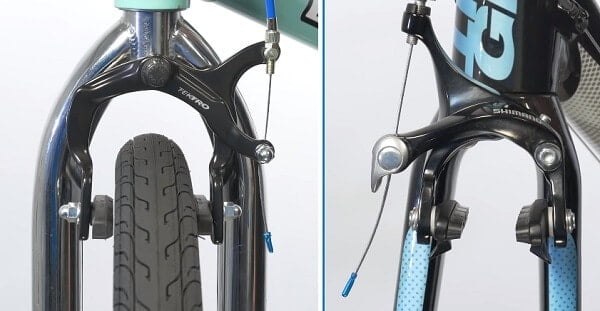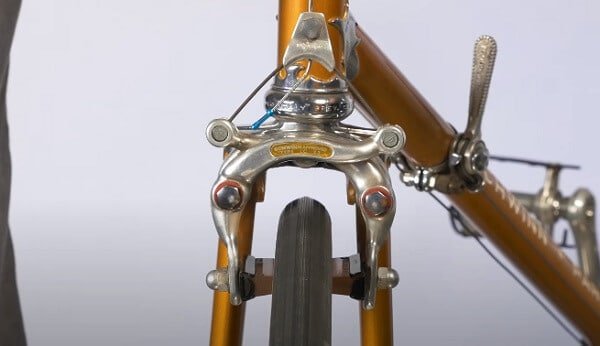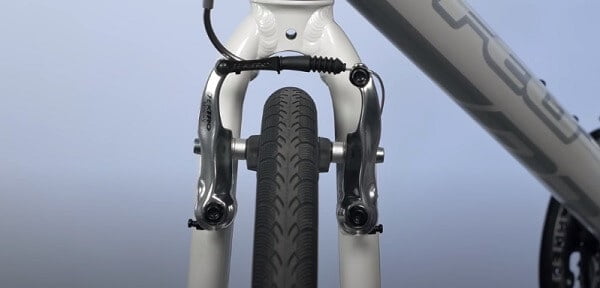Like any vehicle, the primary way to control your bike is through the brakes. Brakes provide the stopping power needed to slow and eventually stop your bike in a safe and controlled manner.
With the plethora of braking options available to us, it can be quite difficult to talk about it all in a single article. Thus we will be focusing on two very popular rim brakes that have been on the road for many decades; the Caliper brake and the V-brake.

Both the Caliper and the V-brake are a different take on the fundamentals of the rim braking system. While in essence they are the same, there are certain aspects which sets them apart and conditions that they thrive in. Some of the differentiating criteria are:
- Cable Actuation Ratios
- Mount Type
- Stopping Power
- Applications or Riding Disciplines
Before we dive into the meat of our discussion, I think it is good to review the question: Why Rim Brakes?
A Few Advantages of Rim Brakes
- They are lightweight.
- They are very easy to maintain.
- Changing tires are very easy with rim brakes.
- Their parts, components and tools are easy to find.
- They are cheap.
With the many strengths of rim brakes in mind, we can tackle the more particular aspects of the two variants of these brakes.
Caliper Brakes VS V-Brakes
Caliper Brakes
Our first, and perhaps the most widely used, cable actuated brakes are the caliper brakes.
Actuation Ratio
Caliper brakes have a 2:1 cable actuation ratio, meaning that for every 2 inches of brake lever pull the cables move 1 inch.
Mount Type and How It Works
We can categorize caliper brakes into two types according to their mechanism:
Side Pull Caliper Brakes
As the name suggests, the side-pull brakes have the braking cable situated at the side. Both of the caliper arms share a single pivot in the middle, located at the center of the fork just above the wheel.
The brake mounts via a mounting bolt that goes through the center of the fork of the frame.
The pads swing on an arc and downward toward the rim. You can adjust the pad height to center on the braking surface of the rims. That is important to understand if you ever change wheels or replace the brakes with new ones.

Center Pull Caliper Brakes
These are usually found on vintage road bikes. Each arm of the brake has a separate pivot. The pivots are located on the sides and just above the wheel. And like the side-pull, the center-pull is mounted on to the frame with a single mounting bolt that goes through the center of the fork.
The cable is pulled from the middle with the straddle wire carrier just above the brake arms. This is where it gets the name center-pull.
The arms move up on an arc as they approach the rim, thus there is a need to adjust their position to be slightly lower than the rim’s braking surface.

Stopping Power
As rim brakes, caliper brakes does its work well like any other. However…
Due to its fixed size of arms and the limited space in between them, they do not perform very well on tires with larger diameters as seen on BMX bikes, mountain bikes or cruisers.
Their efficiency would see a further decrease on fat bike tires, if they are used at all. Fat bike tires are usually under the domain of disc brakes.
But if we are comparing it to other rim brakes, caliper brakes also fall slightly short of V-brakes thanks to its skewed actuation ratio, however it can have a smoother modulation.
When to Use Caliper Brakes?
As you might have guessed, caliper brakes thrive in the road biking scene. This is in part due to road bikes having narrower and streamlined tires.
As long as the rims are fairly dry, the calipers brakes will find enough traction to perform well.
V-Brakes
Rim brakes were often relegated to be only used on road bikes, but that was until the introduction of the V-brake. V-brakes, also called linear pull brakes, revolutionized rim braking for off road bikes.

Actuation ratio
They have a 1:1 cable actuation ratio, meaning that for every inch pull of the brake lever the cable moves 1 inch.
Mount Type and How It Works
Unlike caliper brakes, V-brakes are mounted on the frames of the bike on Braze-ons that are located on the fork or frame of the bike. These Braze-ons are usually located just below the level and on either side of the rim.
A single primary wire pulls the left and right arms are together. The cable housing stop is attached to one arm and the cable extends to the other arm with a pinch bolt. The housing is a rigid tube that has a 90° bend. This housing is also called a ‘noodle’.
Pulling the brake lever brings the pads towards the rim. The motion is fairly horizontal.
Stopping Power
Thanks to its 1:1 actuation ratio, cyclists can get the most out of the brake stopping power. That said, V-brakes tend to boast the greatest stopping power among all types of rim brakes.
When to Use V-Brakes?
V-brakes are dominantly used on mountain bikes and BMX bikes thanks to its mechanical advantages.
These brakes don’t suffer from clearance issues like that of a caliper brake and so can accommodate different diameters of tires.
Being lightweight and cheap, heavy usage can be easily warranted.
To Summarize
| Caliper Brakes | V-Brakes | |
|---|---|---|
| Actuation Ratio | 2:1 Actuation Ratio | 1:1 Actuation Ratio |
| Mount Type | Via mounting bolt that goes through the center of the fork of the bike | Mounted on the frame of the bike via braze-ons that are located on the fork of the bike on either side of the wheel |
| Stopping Power | Good, gets its works done | Great, best among all rim brakes |
| Application | Road Biking | Mountain Biking or Road Biking |
Final Words
Both caliper and V-brakes are great rim brake options for your bike. But looking at them at a fundamental level, it seems that the v-brakes provide a tad bit more versatility when it comes to application.
At the end of the day it is all about making a calculated decision based on the information that you have on your table. It is about weighing the pros and cons and about understanding your preferences.
Frequently Asked Questions
Q1) Can you change caliper brakes to disc brakes?
Ans.: Yes, but it will take a lot of work and is very inefficient. There are a few key differences between rim and disc brakes:
- Has different mounts
- Needs different bike frames
- Needs different wheels
Generally, you will need to preplace all of the parts (that is literally the whole bike!), or you can opt for adaptors for your bike.
The adaptors provide a simple solution but can prove to be very inefficient and setup can be complicated.
It is better to just invest on a second bike.
Watch this video to see how disc brake adaptors work:
Q2) Will V-brake levers work with cantilever brakes?
Ans.: No. While the brakes’ mechanism is essentially the same, the linear pull style of the v-brakes will not be compatible with standard cantilever brakes and levers.
If you have one system already installed and want to make a switch to the other, then you have to buy a ‘traditional’ lever to get the job done, ideally from the same manufacturer.

Hi, are the brake pads of c and v brakes interchangeable?